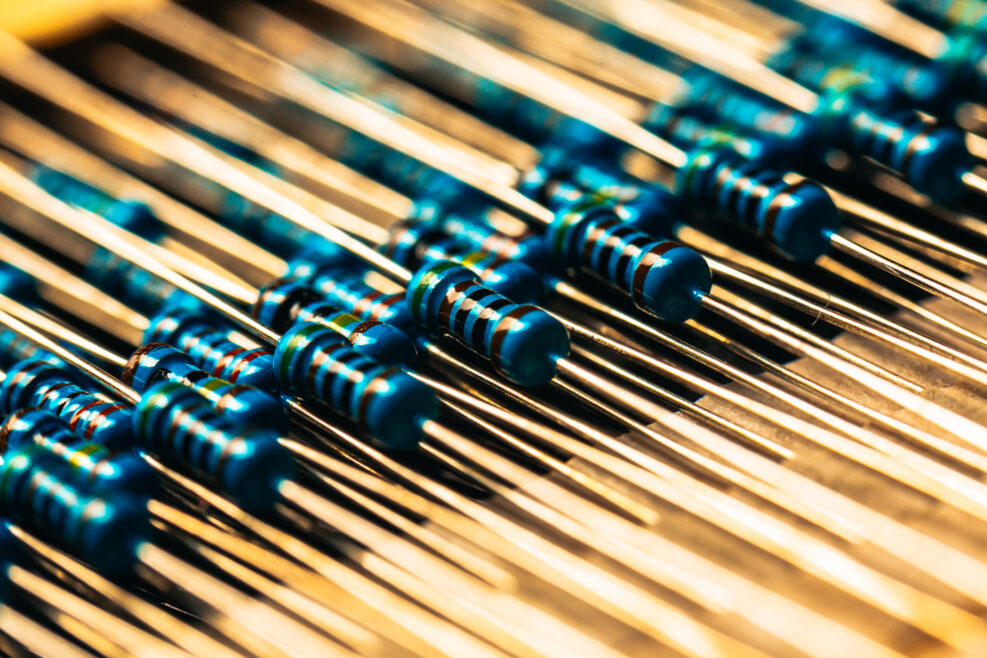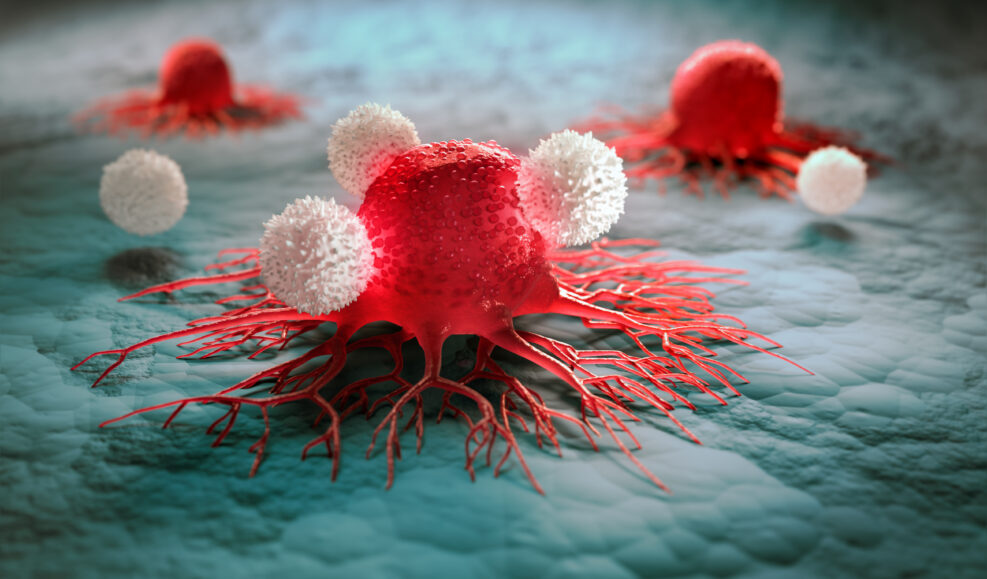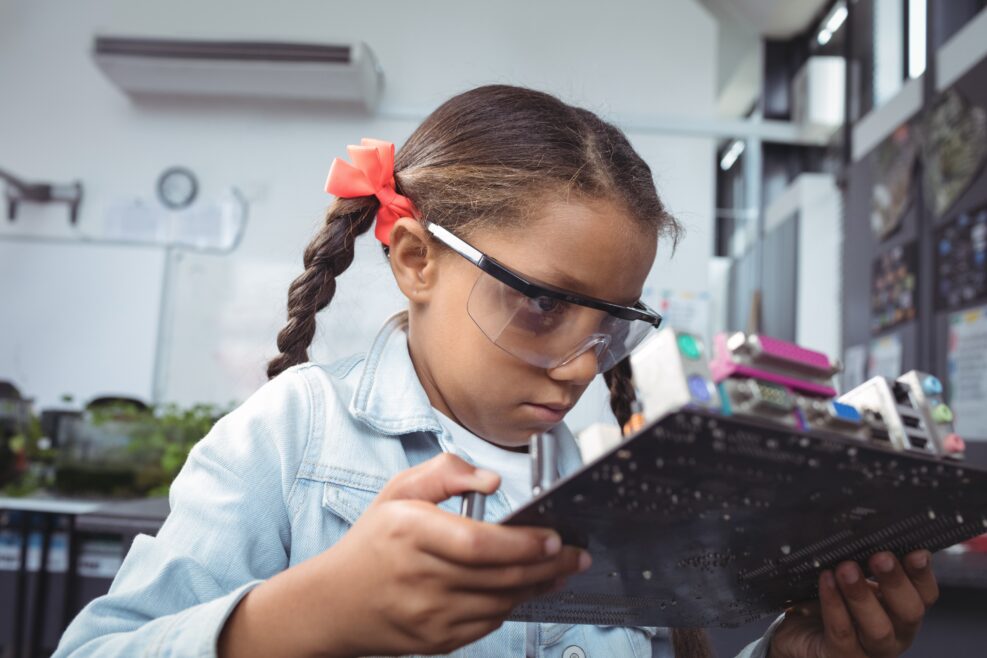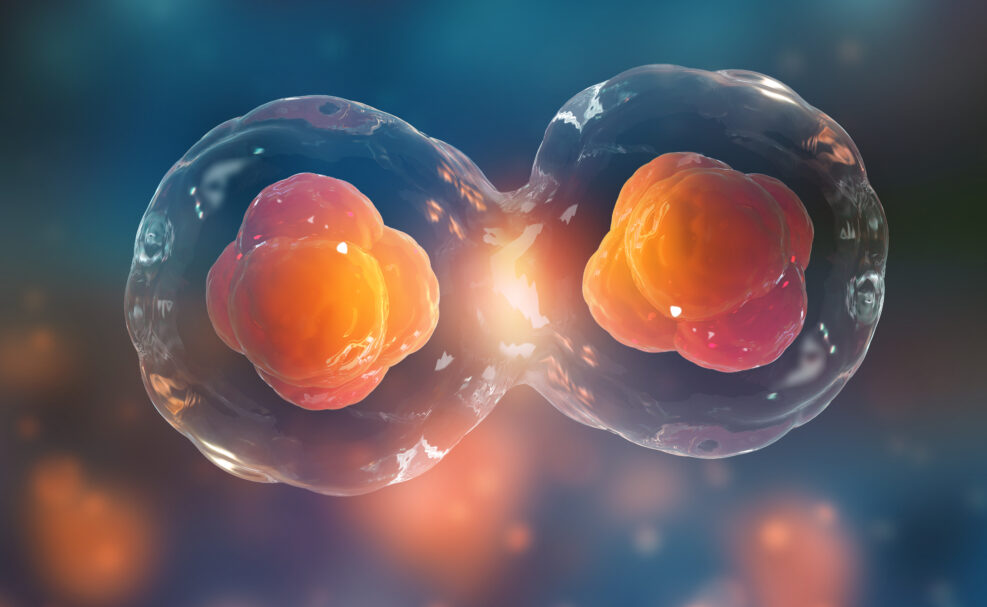
TagFeatured


Why Do Many Scientists See Cells as Intelligent?
Bacteria appear to show intelligent behavior. But what about individual cells in our bodies?Recently, we talked about the ways in which bacteria are intelligent. Researchers into antibiotic resistance must deal with the surprisingly complex ways bacteria “think” in order to counter them. For example, some bacteria may warn others while dying from antibiotics. But what about individual cells in our bodies? A skeptic might say that bacteria are, after all, individual entities like dogs or cats. There is evidence that individual life forms can show intelligence even with no brain. But dependent cells? Surprisingly, cells that are not independent at all but part of a body can also show something that looks like intelligence, as Michael Denton discusses in Miracle of the Cell (2020): No one who has observed a leucocyte (a white Read More ›

Circuit Patterns, Part 2: Voltage Dividers
Pretty much any time you see two resistors connected in series with a wire coming out from between them, you are witnessing a voltage divider in action.In yesterday’s installment, we talked about the importance of circuit patterns, both for understanding the circuit schematics that you might find on the web and for building your own circuits. This series introduces some of the commonly used circuit patterns that are essential to electronics. The first installment covered the most basic resistor pattern, the current limiting resistor. In this article, we are going to look at another basic resistor pattern the voltage divider. Voltage dividers work because resistors, while they limit current, also eat up excess voltage. An LED, for instance, will tend to only eat up a few volts. The excess voltage left over will quickly lead to an overabundance of current. That is why, to work properly, Read More ›

The Social Dilemma: You’re Not the Customer, You’re the Product
A new Netflix documentary explores the techniques used to explore, then shape and sharpen, our attitudes, values, and beliefsWhat is truth? This question has likely been pondered by man for as long as man has been able to ponder. How do you know that what you read or hear is true? How do you know that what you think is true? Why is it that people with different worldviews or belief systems can look at the exact same raw objective data and interpret it in radically different ways? The answers to these questions are important to “know”, insofar as anyone can know anything within a reasonable degree of certainty. However, in our society today, it is becoming more and more difficulty to determine what is true––with any degree of certainty. A recent 90-minute Netflix documentary, The Social Dilemma, Read More ›

Pigeons Can Solve the Monty Hall Problem. But Can You?
The dilemma pits human folk intuition against actual probability theory, with surprising resultsAnimals often outperform humans. My son’s dog is more friendly than I could ever be. Cheetahs run faster, baby horses walk earlier, and elephants can lift more. Birds fly and humans can’t. Is there anything else birds can do better than humans? Yes. Apparently, pigeons learn to solve the Monty Hall problem more quickly. Let’s Make a Deal was a television game show first hosted by Monty Hall (1921–2017) in 1963. There have been various remakes since then. The basic idea is that there are three doors and a contestant’s job is to barter with Monty for the most valuable prize behind the doors. The Monty Hall problem, loosely based on the quiz show, was popularized by Marilyn vos Savant Read More ›

Circuit Patterns, Part I: Understanding Circuit Schematics
You will get on much better in electronics if you learn to see the schematic line drawings as a series of patternsWhen I was young, I wanted to learn how to build electronics. I bought a large number of books from Radio Shack and read them all, cover to cover. Unfortunately, the books that I read helped me to understand a little bit about the periphery of electronics but not the core subject. I learned what each type of part did in general resistors, capacitors, transistors, inductors, etc., but I never really understood how all of the pieces fit together. How do you go from understanding the parts to understand how they fit together into a circuit? Throughout my life, I have returned to electronics now and again, sometimes personally, sometimes professionally. I eventually learned that most electronics follows basic patterns Read More ›

Why a Science Fiction Writer Thinks Life Is More Than Just Matter
Many animals and even bacteria show behavior that smacks of thinking, he says
New Book: Our Bodies’ Cells Are a “Third Infinity” of Information
If the first cell somehow morphed into existence without the ability to reproduce, it would also have been the last cell.Recently, computer engineer and philosopher Jonathan Bartlett pointed out that Elon Musk has inadvertently highlighted the biggest problem with origin of life studies: How life originated is not as difficult a question as how it originated with the ability to reproduce. If the first cell somehow morphed into existence without the ability to reproduce, it would also have been the last cell. The only cell, in fact. Musk, as it happens, was talking about the production of cars when he tweeted, “The machine that makes the machine is vastly harder than the machine itself.” He estimated “1000% to 10,000% harder.” Indeed, and that’s also true of the cells that comprise just about every living being. Our cells not only live Read More ›

They Say This Is An Information Economy. So What Is Information?
How, exactly, is an article in the news different from a random string of letters and punctuation marks?We know information when we see it. An article contains information. A photograph contains information. The thoughts in our mind contain information. So does a computer program and so do our genomes. Yet other things we see around us clearly do not contain information. A handful of toothpicks dropped on the ground does not. Nor do the swirling tea leaves in a cup. Neither does a pair of tossed dice nor a sequence of 100 coin flips. But mere disorder is not the clue. An intricate snowflake does not contain information either. Can we state the difference between the article and the scattered toothpicks precisely? That’s tricky. Both Claude Shannon and Andrey Kolmogorov came up with information metrics. But the Read More ›

Interview: New Book Outlines the Perils of Big (Meaningless) Data
Gary Smith, co-author with Jay Cordes of Phantom Patterns, shows why human wisdom and common sense are more important than ever nowEconomist Gary Smith and statistician Jay Cordes have a new book out, The Phantom Pattern Problem: The mirage of big data, on why we should not trust Big Data over common sense. In their view, it’s a dangerous mix: Humans naturally assume that all patterns are significant. But AI cannot grasp the meaning of any pattern, significant or not. Thus, from massive number crunches, we may “learn” (if that’s the right word) that Stock prices can be predicted from Google searches for the word debt. Stock prices can be predicted from the number of Twitter tweets that use “calm” words. An unborn baby’s sex can be predicted by the amount of breakfast cereal the mother eats. Bitcoin prices can be Read More ›

High-Tech Suppression of China’s Mongol Region Provokes Protests
But Mongolian protesters against Chinese-dominated schools are threatened with loss of social credit, which means no jobs or loansChina is removing the Mongolian language and culture from the curriculum and textbooks in Inner Mongolia (see outline map), an autonomous region in China. In August, leaked government documents showed that language and literature, civics, and history will be taught in Mandarin rather than Mongolian in schools where Mongolian is the primary language. Additionally, the new textbooks replace stories about historic Mongolian heroes with Chinese ballads and expunge a popular folk verse that expresses pride in the Mongolian culture and language. In response, many parents in Inner Mongolia (called Southern Mongolia locally) have been keeping their children from attending school on September 1. In retaliation, state authorities threaten their jobs and social credit status: Southern Mongolia has quickly become a Read More ›

Can AI Write the Great American Novel? Or Compose Sports News?
It’s a split decision, say Rensselaer prof Selmer Bringsjord and Baylor computer engineering prof Robert J. MarksIn a recent podcast, Rensselaer professor Selmer Bringsjord discusses AI and creativity with computer engineering professor and Walter Bradley Center director Robert J. Marks. The difference between writing novels and playing games like Go and chess is that writing novels does not mean winning according to a set of rules. A machine can be programmed with rules and do the calculations faster—much, much faster—than a human. A good novel requires creativity in the face of situations that are only partly definable. If a novel succeeds, many people agree that the writer has captured essential elements of human nature and life circumstances. That’s what makes the great novels so memorable. Sports reporting is somewhere in the middle in that a great Read More ›

Elon Musk Tweet Shows Why Many Doubt Origin of Life Studies
Musk was talking about the origin of machines, not life, but the principle is, perhaps surprisingly, the same
Can Computers Evolve to Program Themselves Without Programmers?
How much computing power would we need to evolve the programmer’s intelligence via Darwinian evolutionAt Science earlier this year, we were told that “Researchers have created software that borrows concepts from Darwinian evolution, including ‘survival of the fittest,’ to build AI programs that improve generation after generation without human input.” Critics say it’s not that easy. Computer scientist Roman Yampolskiy (pictured) discusses the problem in an open access paper, starting with a joke: On April 1, 2016 Dr. Yampolskiy posted the following to his social media accounts: “Google just announced major layoffs of programmers. Future software development and updates will be done mostly via recursive self-improvement by evolving deep neural networks”. The joke got a number of “likes” but also, interestingly, a few requests from journalists for interviews on this “developing story”. To non-experts Read More ›

Why Intelligent Women Marry Less Intelligent Men
Are they trying to avoid competition at home as well as at work? Or is there a statistical reason we are overlooking?When I read that Ruth Bader Ginsburg’s late husband was a wonderful man but less accomplished than his wife, I was reminded of “Ivy,” one of the most impressive students I ever had the privilege to teach. Ivy excelled in her coursework, won a prestigious scholarship for postgraduate study in England, went to a top-five law school, clerked for a Supreme Court Justice, and is now a law professor at a great university. Like Ruth Ginsberg (1933–2020, pictured), Ivy married a man who is very nice but less intelligent than she. This is not an unusual situation. I made a list of the dozen most intelligent female students with whom I’ve kept in touch over the years. These women are Read More ›

How Much Can New AI Tell Us About Ancient Times?
An ambitious new project hopes to use the predictive text that cell phones use to unlock their storiesMany researchers hope that AI will leading to a“golden age” of discovery for lost languages, hard to decipher writings, and badly damaged Biblical scrolls. Algorithms can chug through vast numbers of possibilities of interpretation, presenting the scholar with probabilities to choose from. But even powerful algorithms have their work cut out for them. For example, of the hundreds of thousands of clay (cuneiform) tablets that survive from an ancient part of the Near East called Mesopotamia, many are damaged. We may know the language but we don’t know what’s missing from the text and what difference the missing part makes to what is being said. Experts try to fill in the missing parts but guessing at all the possibilities is Read More ›

Has Microsoft Ever Really Innovated?
That’s a question worth asking, with a history of litigation winning out over innovationAn interesting question in a 2010 discussion thread at Quora is “Why has Microsoft seemingly stopped innovating?” A deeper question is “Has Microsoft ever innovated?” Microsoft’s Bill Gates should be celebrated as a gifted and highly competitive entrepreneur and businessman. But his background as a computer scientist and student of algorithmic information theory is questionable. For this reason, Bill Gates’ assessment of the future of AI should be questioned. Undergraduate Gates dropped out of Harvard University to pursue the founding of Microsoft. He was a knowledgeable programmer with early computer hardware but his more significant talents as an entrepreneur did not require deep studies in computer science. Much of his success came from his business instincts and his team of Read More ›

Can AI Really Evolve into Superintelligence All by Itself?
We can’t just turn a big computer over to evolution and go away and hope for great thingsAt Science earlier this year it was claimed that Darwinian evolution alone can make computers much smarter. As a result, researchers hoped to “discover something really fundamental that will take a long time for humans to figure out”: Artificial intelligence (AI) is evolving—literally. Researchers have created software that borrows concepts from Darwinian evolution, including “survival of the fittest,” to build AI programs that improve generation after generation without human input. The program replicated decades of AI research in a matter of days, and its designers think that one day, it could discover new approaches to AI. Edd Gent, “Artificial intelligence is evolving all by itself” at Science (April 30, 2020) How does that work? The program discovers algorithms using a Read More ›

Evolution And Artificial Intelligence Face The Same Basic Problem
Think of the word ladder game, where we transform one word into another by changing only one letter at a time
Mulan: Disney Talks Freedom at Home, Toes the Line in China
Films we see get altered in subtle and not-so-subtle ways to conform to the requirements of CCP propagandaChina’s government allows only about thirty-four Hollywood movies to be shown in Chinese theaters. As a result, entertainment companies like Disney go out of their way to make sure a film appeals to both North American crowds and Chinese Communist Party’s censors. Of course, what the Chinese Communist Party (CCP) allows and doesn’t allow in films is vague and subject to change, which keeps foreign film-makers guessing. Mulan, Disney’s latest attempt to please both the North American and the Chinese market, has failed to do either, for a number of reasons. Financially, Disney is already hurting from the COVID-19 pandemic. Theaters in the U.S. either remain closed or permit only limited-capacity seating. In response, Disney released Mulan on its streaming Read More ›